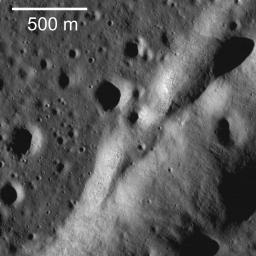
|
Wrinkle Ridges of Northwest Mare Imbrium
- Click the image above for a larger view
- Full-Res JPEG (1000 x 1000) (140.9 kB)
- Full-Res TIFF (1000 x 1000) (1.0 MB)
Caption:
A northeast-trending wrinkle ridge cuts across the plains of Mare Imbrium. The overall ridge is about 4.5 km wide. The contact between the ridge (right) and the surrounding mare basalt plains (left) runs diagonally up the image.
Wrinkle ridges are relatively common on the Moon and are mostly found in the maria; smaller versions are occasionally found in the highlands. They are called "wrinkle" ridges because wrinkling is exactly what happened. Rock (in this case mare basalt) was squeezed from opposite directions, as if it were in a vise, and the rock failed and buckled, or wrinkled, in a direction perpendicular to the squeezing (compression). In detail scientists have found that they are formed by a combination of faulting and folding. Generally there is a broad swell -- the ridge -- and a narrower feature -- the wrinkle. It is the wrinkle that is shown in this frame. In full frame entire structure can be observed. In this area, the overall ridge is about 4.5 km wide and the wrinkle varies from a few hundred meters to just over a km wide. This ridge trends northeast and eventually connects with Montes Recti (a piece of highlands crust protruding through the mare basalts).
Background Info:
NASA's Goddard Space Flight Center built and manages the mission for the Exploration Systems Mission Directorate at NASA Headquarters in Washington. The Lunar Reconnaissance Orbiter Camera was designed to acquire data for landing site certification and to conduct polar illumination studies and global mapping. Operated by Arizona State University, the LROC facility is part of the School of Earth and Space Exploration (SESE). LROC consists of a pair of narrow-angle cameras (NAC) and a single wide-angle camera (WAC). The mission is expected to return over 70 terabytes of image data.
Cataloging Keywords:
| Name | Value | Additional Values |
|---|---|---|
| Target | Moon | |
| System | Earth | |
| Target Type | Satellite | |
| Mission | Lunar Reconnaissance Orbiter (LRO) | |
| Instrument Host | Lunar Reconnaissance Orbiter | |
| Host Type | Orbiter | |
| Instrument | Lunar Reconnaissance Orbiter Camera (NAC) | |
| Detector | Narrow Angle Camera (NAC), Wide Angle Camera (WAC) | |
| Extra Keywords | Grayscale, Mountain | |
| Acquisition Date | ||
| Release Date | 2009-12-14 | |
| Date in Caption | ||
| Image Credit | NASA/GSFC/Arizona State University | |
| Source | photojournal.jpl.nasa.gov/catalog/PIA12931 | |
| Identifier | PIA12931 | |
